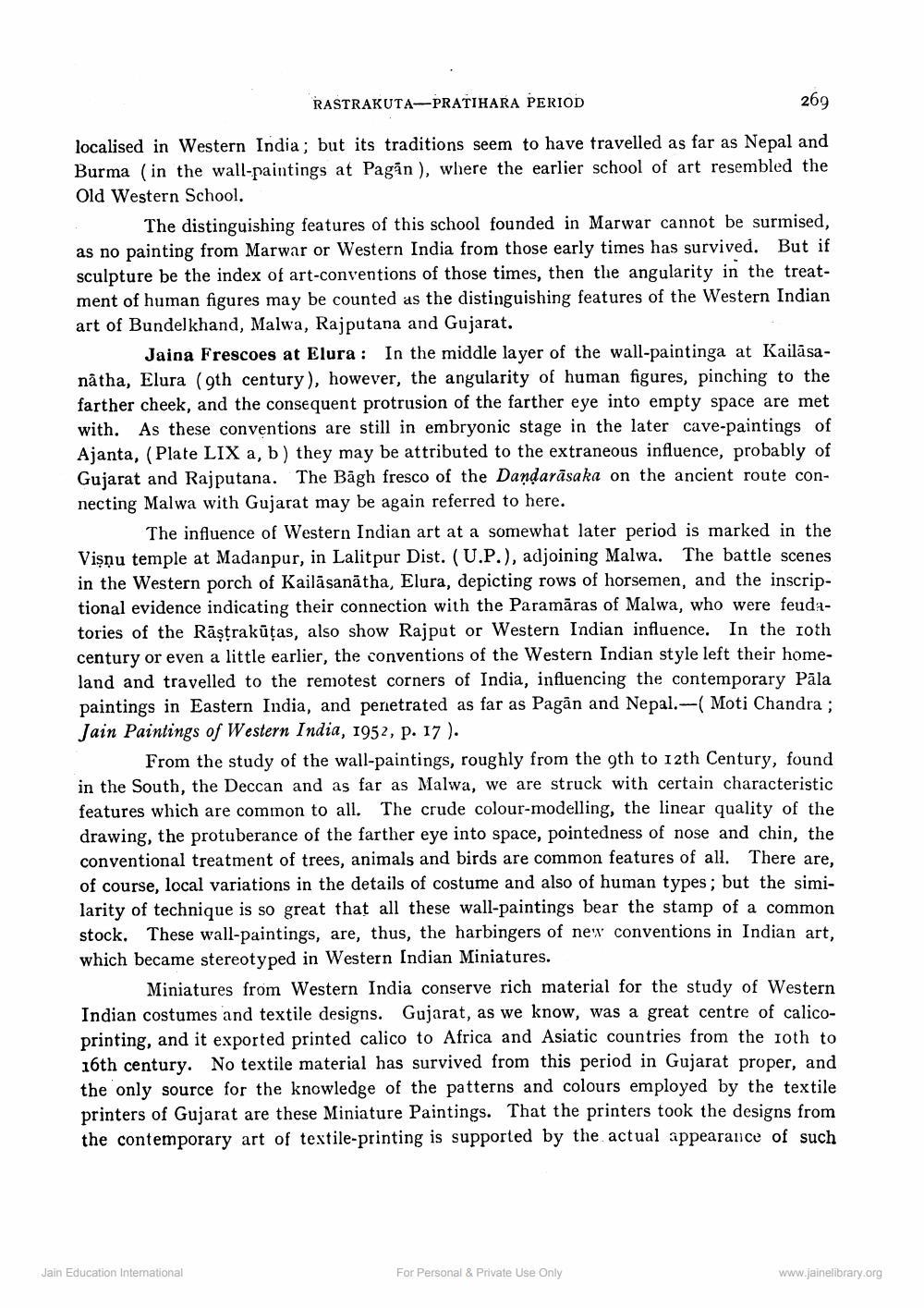________________
RASTRAKUTA-PRATIHARA PERIOD
269
localised in Western India; but its traditions seem to have travelled as far as Nepal and Burma (in the wall-paintings at Pagin ), where the earlier school of art resembled the Old Western School.
The distinguishing features of this school founded in Marwar cannot be surmised, as no painting from Marwar or Western India from those early times has survived. But if sculpture be the index of art-conventions of those times, then the angularity in the treatment of human figures may be counted as the distinguishing features of the Western Indian art of Bundelkhand, Malwa, Rajputana and Gujarat.
Jaina Frescoes at Elura : In the middle layer of the wall-paintinga at Kailāsanátha, Elura (9th century), however, the angularity of human figures, pinching to the farther cheek, and the consequent protrusion of the farther eye into empty space are met with. As these conventions are still in embryonic stage in the later cave-paintings of Ajanta, (Plate LIX a, b) they may be attributed to the extraneous influence, probably of Gujarat and Rajputana. The Bāgh fresco of the Dandarāsaka on the ancient route connecting Malwa with Gujarat may be again referred to here.
The influence of Western Indian art at a somewhat later period is marked in the Vişnu temple at Madanpur, in Lalitpur Dist. (U.P.), adjoining Malwa. The battle scenes in the Western porch of Kailāsanātha, Elura, depicting rows of horsemen, and the inscriptional evidence indicating their connection with the Paramāras of Malwa, who were feudatories of the Rāştrakūtas, also show Rajput or Western Indian influence. In the roth century or even a little earlier, the conventions of the Western Indian style left their homeland and travelled to the remotest corners of India, influencing the contemporary Pāla paintings in Eastern India, and penetrated as far as Pagān and Nepal.-( Moti Chandra ; Jain Paintings of Western India, 1952, p. 17).
From the study of the wall-paintings, roughly from the gth to 12th Century, found in the South, the Deccan and as far as Malwa, we are struck with certain characteristic features which are common to all. The crude colour-modelling, the linear quality of the drawing, the protuberance of the farther eye into space, pointedness of nose and chin, the conventional treatment of trees, animals and birds are common features of all. There are, of course, local variations in the details of costume and also of human types; but the similarity of technique is so great that all these wall-paintings bear the stamp of a common stock. These wall-paintings, are, thus, the harbingers of nex conventions in Indian art, which became stereotyped in Western Indian Miniatures.
Miniatures from Western India conserve rich material for the study of Western Indian costumes and textile designs. Gujarat, as we know, was a great centre of calicoprinting, and it exported printed calico to Africa and Asiatic countries from the 10th to 16th century. No textile material has survived from this period in Gujarat proper, and the only source for the knowledge of the patterns and colours employed by the textile printers of Gujarat are these Miniature Paintings. That the printers took the designs from the contemporary art of textile-printing is supported by the actual appearance of such
Jain Education Intemational
For Personal & Private Use Only
www.jainelibrary.org




